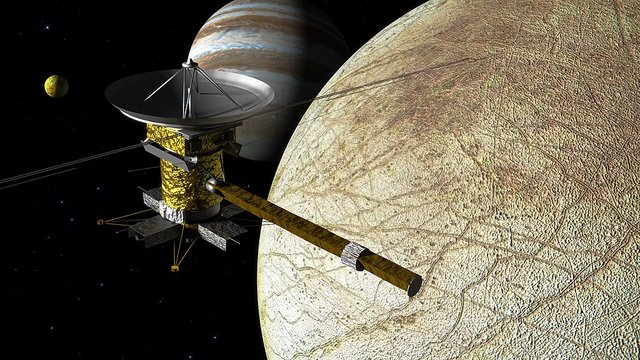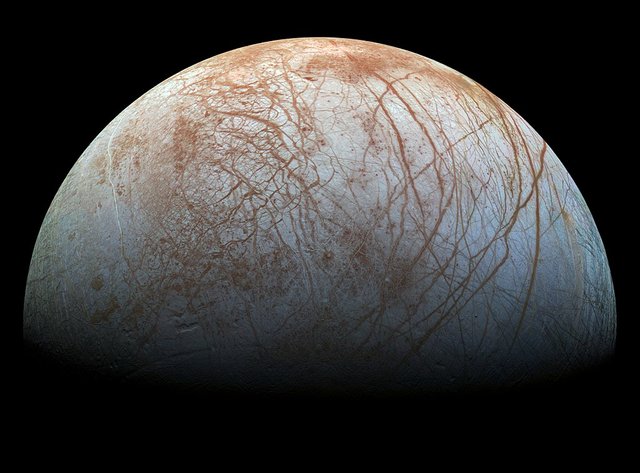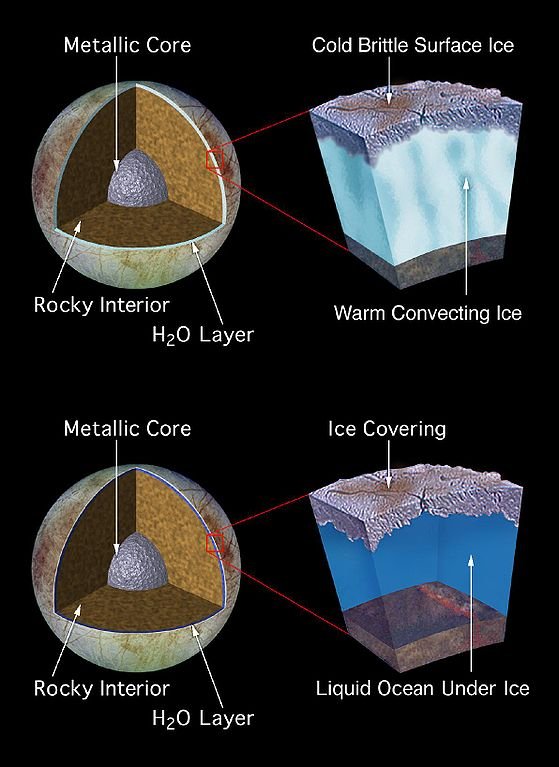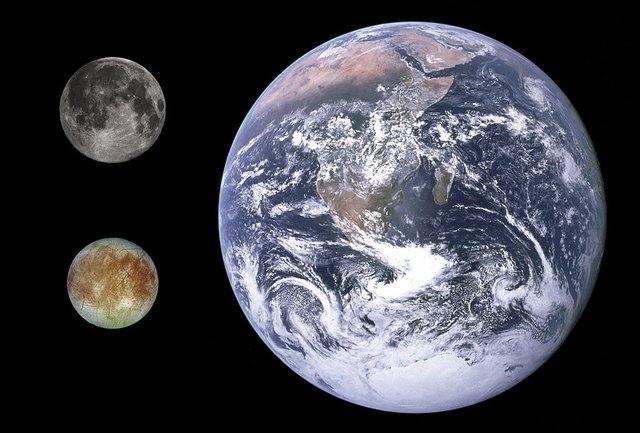Planetary moons #5 : Europa
I will describe this time the fourth largest, Jupiter's galilean moon - Europe. Scientists believe that extraterrestrial life could have developed here, because there is water under the ice shell of the satellite. The surface of Europe is ice tectonic plates floating on a huge ocean.
NASA's Clipper spacecraft sailing high above Jupiter's moon Europa

By Kevin Gill from Los Angeles, CA, United States link [CC BY-SA 2.0 license]
The moon was discovered in 1610 by Galileo. Europe is the second after Io moon close to Jupiter. It circulates the planet within 3.5 days. This satellite is in the orbital resonance with Ganymede and Io, which causes tidal processes as for Io. They are probably the source of energy that keeps the internal ocean of liquid water. Europe is next to Enceladus one of the two satellites where geysers were observed. Those on Europe can shoot water over 200 kilometers! Despite the heat inside the moon, its surface is very cold. The temperatures that prevail here are from -160 * C at the equator to -220 * C at its poles. The most interesting feature of the surface of the satellite are lines on the ice crust, they look like ice cracks.
Realistic color Europa mosaic

By NASA link [Public domain]
The construction of Europe isn't known to us. Probably the moon has a metallic core surrounded by a rock cloak. Then there is a layer of salt ocean about 100 km thick. It would mean that the volume of water in Europe is 2 times higher than on Earth! Ice tectonic plates float on this ocean. At their junctions, geysers are formed, where water escapes to the surface, instantly freezing. The satellite has a very rare atmosphere, mainly made of oxygen.
Model of Europa's subsurface structure

By NASA link [Public domain]
At the end, we compare the size of Europe, our Moon and Earth. The diameter of Europe is 3122 km, making the satellite a little smaller than our Earth's Moon. Europe will be the target of the JUICE mission (Jupiter Icy Moons Explorer). The probe will go there in 2032. Then we will know new information for sure. I hope that we will wait for it. This moon certainly has many amazing secrets.
Europa, Earth & Moon size comparison

Apollo 17 Picture of the Whole Earth: NASA, Telescopic Image of the Full Moon: Gregory H. Revera, Image of Europa: NASA/JPL link [Public domain images and CC BY-SA 3.0 license for moon image]
Greetings to lovers of Astronomy!
Sources:
Europa
Galilean moons
Jupiter
and my knowledge...
All rights reserved by @astromaniac 2018
This post has been voted on by the steemstem curation team and voting trail.
There is more to SteemSTEM than just writing posts, check here for some more tips on being a community member. You can also join our discord here to get to know the rest of the community!
Hi @astromaniac!
Your post was upvoted by utopian.io in cooperation with steemstem - supporting knowledge, innovation and technological advancement on the Steem Blockchain.
Contribute to Open Source with utopian.io
Learn how to contribute on our website and join the new open source economy.
Want to chat? Join the Utopian Community on Discord https://discord.gg/h52nFrV
Congratulations @astromaniac! You have completed the following achievement on Steemit and have been rewarded with new badge(s) :
Click on the badge to view your Board of Honor.
If you no longer want to receive notifications, reply to this comment with the word
STOPTo support your work, I also upvoted your post!
Do not miss the last post from @steemitboard:
SteemitBoard World Cup Contest - The results, the winners and the prizes